Mulberry (Morus), also called mulberry, or mulberry tree, is a deciduous tree belonging to the genus of the Mulberry family. According to information taken from various sources, this genus unites 17-24 species. These plants in natural conditions can be found in the temperate and subtropical zone of Africa, North America and Asia. Among the most popular species is the white mulberry, silkworm larvae feed on its foliage, their pupae are used for the production of natural silk. Under Ivan the Terrible in Russia they already knew about mulberry, at that time a silk-weaving manufactory was created, in which they made very delicate fabric for the royal court. In turn, Peter I forbade cutting mulberries on the territory of the state, since they were considered very valuable. The dense, resilient and heavy wood of the mulberry tree is also very valuable; in Central Asia it is used for the manufacture of various crafts, musical instruments and barrels.
Content
- 1 Features of mulberry
- 2 Planting mulberries in open ground
- 3 Growing mulberries in the garden
- 4 Mulberry pruning
- 5 Mulberry propagation
- 6 Mulberry diseases with photos and descriptions
- 7 Mulberry pests with photos and descriptions
- 8 Types and varieties of mulberry with a description
- 9 Mulberry properties: benefits and harms
Features of mulberry
While the mulberry is young, it is characterized by extremely fast growth, but over time it becomes slower. As a result, the height of such a tree does not exceed 15 meters. Simple leaf plates are often lobed, they are alternately spaced and serrated along the edge. Spike-shaped inflorescences consist of small flowers, which are either female or male (dioecious). However, there are such mulberry trees on which both female and male flowers (monoecious) can open simultaneously. The length of the fleshy mulberry fruits is from 20 to 30 mm, they are false berries, or rather, drupes of various colors (from dark purple, almost black, to white) connected into one whole.This plant is distinguished by its unpretentiousness, it is able to grow and develop normally, even if it is not looked after at all. The mulberry tree begins to bear fruit in the fifth year of life. The average lifespan of such a plant is about two hundred years, today there are specimens that are at least 500 years old.
The most popular among gardeners are 2 types of mulberry - black and white, while they differ in the color of the bark, and not the fruit. In a white mulberry tree, the bark on the branches is colored in a light color (cream, pale yellow or white), while the branches of the black mulberry tree are covered with a darker bark. Today, this plant is as widespread in culture as other fruit trees, for example: cherry, plum, apple, sweet cherry, etc.
Planting mulberries in open ground
What time to plant
You can plant mulberries in open soil in springtime in April before sap flow begins, or in autumn in September and October, but you need to catch it before the rainy season. Many gardeners recommend planting in the fall, as it is believed that if the tree survives the winter months, then it is destined to live for many years.
Try to find the most suitable place for the plant in your garden. Mulberry prefers well-lit areas with reliable protection from the cold wind. Mulberries should not be planted on swampy, sandy and saline soil, and the groundwater on the site must lie at a depth of at least 150 cm.Plants with only male flowers cannot bear fruit on their own, however, it is possible to find out the floor of the seedling only after he will be 4 or 5 years old. In this regard, experienced gardeners recommend buying three-year-old seedlings that gave the first offspring.
Planting mulberries in autumn
A pit for planting should be prepared at least 15 days before the day of planting, its size directly depends on the size of the plant's root system. It should be borne in mind that the roots must be placed in the pit freely. The average size of the pit is 0.5x0.5x0.5 m. In the event that the soil on the site is poor, then the depth of the pit is increased, since compost or rotted manure in the amount of 5-7 kilograms will have to be poured onto its bottom, to which 100 gram of superphosphate. This layer must be sprinkled with soil, as it should not come into contact with the root system of the plant. After half a month after preparing the pit, you need to start planting a mulberry tree directly. The root system of the seedling must be placed in the pit, after it is straightened, it is added dropwise, while the stem must be shaken all the time, otherwise there will be many voids in the soil. When the plant is planted, the soil in the trunk circle must be tamped, then 20 liters of water are poured under it. When the liquid is completely absorbed into the soil, the surface of the trunk circle must be covered with a layer of mulch. For a thin and weak seedling, you will need a support, which is driven into the center of the bottom of the pit before planting. When the mulberry tree is planted, it should be tied to this support. If the soil on the site is clayey and heavy, then at the bottom of the pit it is imperative to make a drainage layer of broken brick.
Spring planting
Planting mulberries in open ground in autumn and spring is almost the same. The difference is that for the spring planting the foundation pit is prepared in the autumn, while the necessary nutrient mixture is poured into it. Planting is carried out in early spring, it must be completed in April.


Watch this video on YouTube
Growing mulberries in the garden
You need to take care of the mulberry tree grown in the garden in the same way as for other crops. It needs to be watered, weeded, cut, fed, treated against pests and diseases in a timely manner, as well as the surface of the trunk circle should be loosened.
Mulberry processing
In order to significantly reduce the risk of damage to a tree by various diseases or pests, it is necessary to regularly carry out preventive treatments, while it is necessary to spray not only the plant itself, but also the surface of the trunk circle. For treatments, insecticides and fungicides are used. It is recommended to carry out such spraying in the first days of April on dormant buds, as well as in October, when the growing season ends. A solution of Nitrafen or Bordeaux mixture (3%) will help you cope with various diseases and pests. In spring, it is recommended to spray the tree with a solution of urea (7%), which will exterminate all pests and pathogenic microorganisms, and will also become a source of nitrogen for the plant, which is so necessary for it at the beginning of the growing season.
Mulberry watering
To make the mulberry tree more winter-hardy, it must be watered regularly from the beginning of spring to July. This should be done during a severe drought. Since July, the plant cannot be watered. If there is a large amount of rain in the spring, then you do not need to water the mulberry.
Mulberry feeding
From the beginning of spring to July, such a tree needs additional feeding. In the spring, the plant most of all needs nitrogen fertilizers, and in the summer - in potash and phosphorus.
Mulberry in the suburbs and in Moscow
The Moscow region and Moscow climate is not quite suitable for growing mulberries. However, it has long been learned there to grow such southern crops as apricots, grapes, and mulberries are no longer so rare. This plant, covered with snow, can survive a drop in air temperature to minus 30 degrees. However, if the winter period turns out to be of little snow, then the mulberry tree may die already when the temperature drops to minus 7-10 degrees. In this regard, during the planting of mulberries in the Moscow region, its root collar should not be buried very much into the soil.
Since the duration of daylight hours in the Moscow region does not meet the requirements of mulberry, such a plant that is grown in the Moscow region has 2 growing seasons per year - in spring and autumn. This tree has an unusual ability, it can form cork tissue between the mature and immature part of the stem. As a result, a mulberry tree in autumn can throw off those parts of the shoot that are not viable, which will allow it to survive the winter well. In this regard, in the autumn in the Moscow region and Moscow, such a culture fly around not only leaf plates, but also parts of the stems. This is the only difference in mulberry cultivation compared to warmer regions.
Mulberry in Siberia
It is possible to cultivate this plant in Siberia only if its frost resistance is increased. It is difficult to do this, but it is possible if desired. If a gardener has a very strong desire to grow mulberry trees in a region with a cold climate, then he should definitely study the articles of experienced gardeners V. Shalamov and G. Kazanin.


Watch this video on YouTube
Mulberry pruning
Mulberry pruning is recommended during partial or complete rest. The tree tolerates pruning best in early spring, before sap flow begins. As a rule, rejuvenating and formative pruning is recommended from the last days of April to the first - May before the kidneys open. In autumn, when leaf fall ends, sanitary pruning is carried out, while the air temperature outside should not be less than minus 10 degrees.
How to prune mulberries
Different types of mulberry trees have different pruning characteristics. For example, a weeping mulberry needs thinning pruning, as well as cutting stems and branches. Since this species is restored in a relatively short time, even very strong pruning is not afraid of it.
A stamped mulberry tree needs only crown shaping.To do this, on a long stem, on which there are completely no branches, you need to form a lush spherical cap or a falling cascade of branches.
The decorative mulberry is the most difficult to form. It will also be difficult to systematically maintain the original shape of the tree.
Mulberry pruning in spring
While the plant is young, all branches must be cut off from its trunk to a height of 150 centimeters. In this case, in an adult plant, the branches will not fall to the surface of the site. The preserved conductor can grow up to 5–6 meters by trimming all competing stems. If you don't want to do formative pruning, then just let the crown grow naturally. You can form a not very tall tree, which is convenient to care for. To do this, the apical shoot must be cut at a height of 1.35–1.7 m, then a skeleton is formed, which should be similar to a dwarf apple tree. Such a tree should have 8 to 10 skeletal branches. When the plant is formed, you will need to maintain the created shape, for this, cutting and plucking those stems that are not needed. It is not recommended to prune drooping branches; instead, they must be supported.
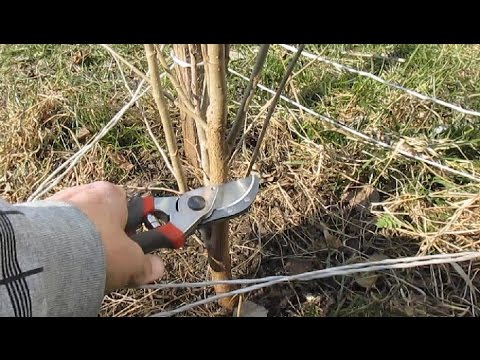

Watch this video on YouTube
Pruning mulberries in autumn
When all the foliage flies from the tree in autumn, you need to start preparing it for wintering. So, at this time, it is necessary to make mandatory sanitary pruning, for this you should cut out all injured, dried, damaged by frost or disease, excessively thin branches and stems, as well as those that grow inside the crown. As a rule, mulberry trees do not need annual sanitary pruning.
Mulberry propagation
Mulberries can be propagated in a generative (seed) way, as well as vegetatively - by grafting, offspring, lignified and green cuttings, and also by layering.
How to grow from seeds
The seeds should be removed from the fruits of the current season from about the middle to the last days of October by removing all the pulp. Then they are immersed in a solution of a growth stimulating agent (for example, Zircon or Epin) for 1–2 hours. After that, they are sown in open soil. In the event that you will be engaged in sowing at the beginning of the spring period, then the seeds will need to be stratified before that for 4-8 weeks. It is possible not to stratify the seeds, but in this case they will need pre-sowing preparation. To do this, in the spring, immediately before sowing, the seeds must be immersed in cold water for 24 hours, then they are removed and kept for the same amount of time in very warm water (from 50 to 53 degrees).
For the garden bed, choose a well-lit, unshaded place. Then you need to prepare the grooves and spill them with water, having previously dissolved in it fertilizers intended for fruit and berry crops. The seeds of this plant are small, and they should be sown as rarely as possible. They should be buried in the soil by 30-50 mm. The garden bed must be well watered when the seeds are embedded in the soil, and then its surface is covered with a layer of mulch. In autumn, the mulching layer is made thicker than in spring, since in winter the seeds can freeze out. The seedlings that appear need to be systematically watered, weeded and fed. By the onset of the autumn period, grown and strengthened seedlings can be planted, while, depending on the mulberry variety, the distance between the plants should be 3-5 meters. A plant grown from seed begins to bear fruit after 5 or 6 years. This method of reproduction has one significant drawback, namely, a tree that has grown from seeds inherits only part of the varietal traits of the parent plant, or does not inherit them at all. In this regard, seedlings grown in this way are most often used as rootstocks for budding.
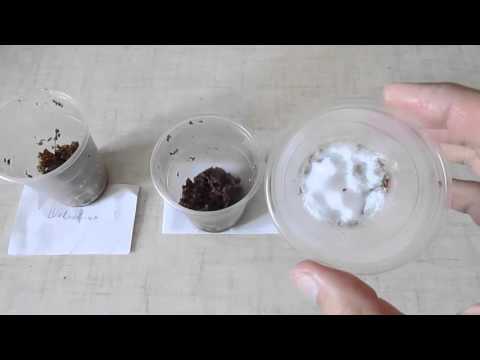

Watch this video on YouTube
Mulberry propagation by offspring
If in a very cold winter the mulberry tree suffers greatly from frost, then its developed root offspring can be used to replace the frozen tree. On this offspring, a crown is gradually formed. Unnecessary shoots should be removed, and if desired, they can be removed from the soil along with the root system, the stems should be shortened by 1/3 part and then used as seedlings. This method is good because the offspring are able to fully preserve the varietal characteristics of the parent plant.
Mulberry propagation by cuttings
If the tree is rooted, then green cuttings can be used to propagate it. But the complexity of this method is that you will need a special installation that can create a fine water suspension in the form of fog in the greenhouse. Cuttings are harvested in June-July, at which time the plant has an active mulberry growth. Cuttings are cut from the stems, which should be 15 to 20 centimeters long and have 2 or 3 buds. They are planted in the greenhouse at an angle of 45 degrees. In very loose soil, the lower cut of the cutting should be stuck to a depth of 30 mm. Only a couple of upper leaf plates should be left on the handle, which are shortened by ½ part. It is necessary to make sure that there is a high humidity environment in the greenhouse. Young shoots and a powerful root system in plants will appear by autumn, but their planting in open soil should be postponed until the next spring period.
Mulberries can also be propagated by semi-lignified cuttings, which are harvested at the same time as green ones. Such cuttings should be rooted in the same way as green ones. The disadvantage of such reproduction is that the rooting of semi-lignified cuttings is relatively slow. A tree grown in this way inherits absolutely all varietal characteristics of the parent plant.
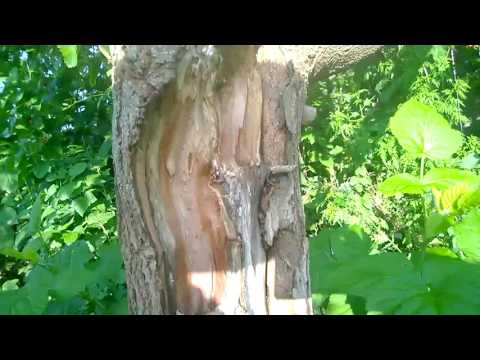

Watch this video on YouTube
Mulberry grafting
All known methods can be used to inoculate mulberry trees. However, experienced gardeners recommend opting for copulation (grafting on a cut with a cuttings). If simple copulation is used, then the scion and rootstock are spliced, the thickness of which should be the same. On the rootstock and the scion between the two buds, you need to make oblique cuts, while their length should be equal to the diameter of the spliced plants, multiplied by 4 (for example, if the diameter of the rootstock and scion cutting is 1.2 cm, then the length of the sections will be 4.8 cm ). Align the sections with each other and wrap them with any elastic material or eyepiece tape.
An improved copulation with a tongue is also used. To do this, cuts must be made on the cutting and rootstock in the same way as described above, after which they must be supplemented with notches-tongues. It is necessary to retreat from the end of the cut 1/3 of its length, then an incision is made to the middle of the cut on the scion up, and on the rootstock down. Places of cuts must be attached to each other, after which the tongues are wound in such a way that they are very closely aligned. At the very end, the vaccination site must be wrapped with tape.


Watch this video on YouTube
Mulberry diseases with photos and descriptions
The mulberry tree has a rather high resistance to various diseases, but in some cases it can also get sick. Most often he suffers from brown leaf spot (cylindrosporiasis), curly small leaves, powdery mildew and bacteriosis. The tree can also be damaged by the tinder fungus.
Powdery mildew
Powdery mildew is a fungal disease. In the affected plant, a whitish bloom forms on the surface of the stems and leaf plates. In the dry period, the disease develops most actively, especially if the crown of the plant is thickened. As soon as the first symptoms of the disease are found, the tree must be sprayed with Bordeaux mixture, Fundazol, or a suspension of colloidal sulfur. For prophylaxis, in the autumn, you need to rake and destroy all the foliage that has flown around.
Cylindrosporiasis
Brown leaf spot is also a fungal disease. In the affected specimen, spots of red-purple color are formed on the surface of the leaf plates, which have an annular border. As the disease progresses, the leaf tissue inside the spots spills out, the foliage itself turns yellow and flies around. As soon as the first signs of the disease are noticed, the tree should be treated with Silita solution (1%). In this case, about 3 liters of this solution should go to one plant. Re-processing is carried out half a month after the first.
Bacteriosis
Most often, young stems and leaf plates of a mulberry tree are affected by bacteriosis. Irregular specks appear on their surface, over time they turn black. As a result of the development of the disease, twisting and flying of the foliage occurs, as well as deformation of the stems, while gum-like clots are formed on their surface. To combat this disease, the drug Gamair or Fitoflavin is used. However, it should be noted that it is not always possible to cure a plant with bacteriosis. In this case, you must try to prevent infection by regularly carrying out preventive treatments.
Small-leaved curl
Pests are carriers of such a viral disease as small-leaved curl. In a diseased tree, the foliage shrinks between the veins, and then grainy nodularity forms. As the disease progresses, the leaf plates shrink and fold, the stems become very fragile and rough, while an abnormal increase in their number is observed. This disease cannot be cured, which is why preventive measures are so important. To prevent the plant from becoming infected, it is necessary to fight against insect vectors, these include all sucking pests, for example: thrips, aphids, ticks, etc.
Tinder
The tinder fungus settles on a tree and leads to the destruction of its wood. Its spores, getting into wounds and cracks in the bark, parasitize the plant, which leads to the destruction of its trunk. After such a mushroom is found, it must be cut out, capturing part of the wood, and destroyed. The resulting wound should be treated with a solution of copper sulfate (5%). Then it must be covered with a mixture, for the preparation of which you need to combine lime, clay and cow dung (1: 1: 2). If there is mechanical damage on the surface of the tree and gum flows out of them, then it is necessary to clean these wounds, then they are disinfected with a solution of copper sulfate (1%), and then they are treated with a solution consisting of Nigrol and wood ash, which needs to be sieved, are taken these components in a ratio of 7: 3.
Mulberry pests with photos and descriptions
Pests on mulberry rarely settle. Most often, this plant is harmed by American butterflies, Comstock worms, spider mites and mulberry moths.
White american butterfly
The greatest danger to the mulberry tree is the white American butterfly. The caterpillars of this pest are brown-green, with orange-yellow stripes on the sides and black warts on their surface. These caterpillars are able to gnaw all the foliage on the mulberry. Inspect the tree, cut and destroy the found spider nests. It is necessary to install special trapping belts on the trunk, and the crown of the plant must be sprayed with Chlorophos.
Mulberry moth
The caterpillars of the mulberry moth also feed on the foliage of this culture. To protect the plant from such pests, it should be treated with Chlorophos in the spring, when the buds are just beginning to swell, because it is at this time that such caterpillars appear.
Spider mites
If spider mites settle on a tree, then the finest cobwebs can be seen on it. The pests themselves are very small and cannot be seen with the naked eye.However, such mites pose a great danger to mulberries. Mites pierce the surface of the leaf plates and suck the juice out of them. As a result, the foliage becomes brown and flies around. You should also know that this pest is one of the main carriers of viral diseases that cannot be cured. A tick is an arachnid insect, therefore, to exterminate it, it is necessary to use acaricidal agents, for example: Actellik, Kleschevit, etc.
Worm Comstock
Another sucking insect is the Comstock worm. It settles on foliage, bark and branches of mulberry trees. The worm also feeds on the sap of the plant, as a result of which it is greatly weakened. Because of such a pest, tumors and wounds appear on the tree, deformation and drying of the branches occur, and the foliage turns yellow and flies around. To destroy the worms, the tree needs to be sprayed with pesticide.
Types and varieties of mulberry with a description
Mulberry has an extremely confusing classification. According to information taken from various sources, this genus unites 17-200 species. The fact is that there are a large number of natural mulberry hybrids, which individual scientists distinguish into independent species. Below will be described 3 types of mulberry trees that are most popular with gardeners.
Red mulberry (Morus rubra)
The homeland of this species is North America. This plant is distinguished by its hardiness, unpretentiousness and resistance to cold and drought. The height of such a tree can vary from 10 to 20 meters. The crown has the shape of a tent. The bark is brownish brown. In length, leaf plates reach 12 centimeters, they can be rounded, long-pointed or ovoid, their front surface is rough, and the wrong side is felt. Leaf plates on young shoots are deep-lobed. Sweet-sour juicy fruits reach 30 mm in length, they have a dark red, almost black color. Outwardly, they are similar to the fruits of blackberries. Ripening of mulberry fruits is observed in the last days of July. As a rule, representatives of this species are dioecious plants and therefore, in order for them to bear fruit, they need a pair of the opposite sex. Monoecious plants are very rare. This species has a decorative form - felt mulberry: the seamy surface of the leaf plates has a dense pubescence of white color.
Black mulberry (Morus nigra)
The homeland of this species is Afghanistan and Iran. The height of such a tree with a spreading crown can reach no more than 15 meters. Large, asymmetrical leaf plates have a broad-ovoid shape, their length is about 20 centimeters, and their width is about 15 centimeters. Their front surface is rough, and the wrong side is felt. The shiny, black fruits are about 30 mm long and have a sweet and sour taste. This species is resistant to drought, but has less winter hardiness than white and red mulberries. New shapes have been generated based on the base view:
- Repaired... It is a very compact dwarf form. It is often cultured in a container.
- Shelley number 150... This large-fruited form is distinguished by its yield. The length of juicy and sweet fruits can reach 55 mm. The foliage is also very large, its length can be up to 50 cm. Such leaf plates are used for decorative purposes.
The following varieties are most popular with gardeners: Royal, Black Prince, Black Pearl, Fruit-4 and Nadezhda.
White mulberry (Morus alba)
The homeland of this species is China, where it prefers to grow in deciduous forests. The height of a tree with a lush spherical crown can reach 20 meters. Fissured bark is colored brown. The bark of young branches is colored in various shades from brown-red to green-gray. Interestingly, leaf plates of various sizes and shapes can grow on the same tree. In summer, the color of the foliage is dark green, and in autumn it is yellow-straw.Fruit fruits of sweet taste can be colored in different colors, their shape is similar to the shape of raspberries or blackberries. This species is characterized by winter hardiness, unpretentiousness and endurance to urban conditions. There are a large number of decorative forms:
- Weeping... Such a plant can reach a height of 5 meters. Its drooping branches are very thin.
- Pyramidal... The height of such plants with a narrow pyramidal crown does not exceed 8 meters. The leaf plates are bladed.
- Spherical... The lush crown has a spherical shape.
- Spoon-shaped... Such a multi-stemmed tree reaches a height of 5 meters. Foliage is concave folded. The berries ripen relatively early.
- Large-leaved. The length of the foliage is about 22 centimeters.
- Common narrow-leaved... In this bushy form, small leaf plates are notched and very rough.
- Dissected... Such a plant is distinguished by its elegance. The leaf plates are divided into regular narrow blades. A pair of lateral and apical lobes are too elongated.
- Golden... The color of young shoots and foliage is yellow-golden.
- Tatarskaya... This undersized tree is characterized by slow growth and high frost resistance. Small leaves are multi-lobed.
If you want to grow mulberries for fruit, and not for garden decoration, then you should pay attention to highly productive varieties of white mulberry:
- White honey... Such a tall plant grows very sweet white berries, reaching a length of 30 mm.
- Dark girl... The variety is distinguished by its yield and winter hardiness. Black berries have a sweet-sour taste and are about 35 mm long.
- White tenderness... The variety has a high yield. Delicate white berries reach 50 mm in length.
- Luganochka... The variety is highly productive. The sweet cream-colored berries are about 55 mm long.
- Black Baroness... The variety is early-maturing winter-hardy. Sweet fragrant berries reach 35 mm in length.
- Staromoskovskaya... The variety with a spherical crown is winter-hardy. The sweet fruit is almost black in color and is about 30 mm long.
- Ukrainian-6... This early maturing variety is distinguished by its yield. Black berries reach 40 millimeters or more in length.
Also popular are such varieties as: Diana, White tenderness, Snow White and Mashenka.
The varieties with the largest fruits are White Tenderness, Shelley No. 150, Black Pearl and Black Prince.
Black mulberry varieties are not suitable for growing in the Moscow region. However, some varieties of white mulberry have been successfully cultivated in mid-latitudes for many years, namely: Vladimirskaya, Korolevskaya, White honey and Staromoskovskaya.
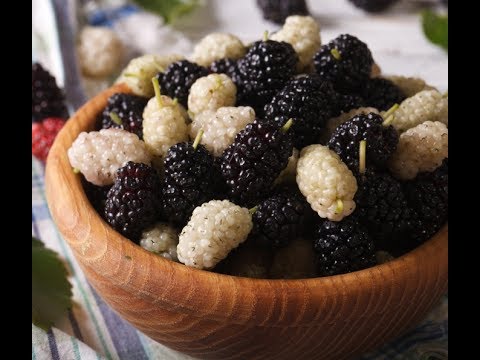

Watch this video on YouTube
Mulberry properties: benefits and harms
Useful properties of mulberry
Mulberry has healing properties, and this is due to the included in its composition: vitamins A, K, E and C, microelements selenium, iron, manganese, zinc and copper, macroelements phosphorus, magnesium, calcium, potassium and sodium. Ripe berries contain riboflavin, pantothenic and folic acids, tocopherol, pyridoxine and choline.
In alternative medicine, such fruits are widely used. Green fruits help with heartburn and diarrhea, and ripe fruits have a laxative effect and are used for constipation. For sore throat, it is rinsed with fruit juice, which is diluted with boiled water. For bronchitis, acute respiratory infections and bronchial asthma, an infusion of fruits and bark is used.
An infusion of foliage is used as an antipyretic agent for fever. With hypertension, it is recommended to use a decoction of the bark and roots, which has a diuretic effect. Experts advise a person with myocardial dystrophy and heart disease to eat as many mulberry fruits as possible: 4 times a day, 0.3 kg for 4 weeks.
A decoction of dried fruits should be drunk with insomnia and stress, since it contains many B vitamins, which have a positive effect on carbohydrate and protein metabolism, and also support the activity of the nervous system.
Fruits are also recommended to be eaten during the recovery period after surgery, as well as during physical overload. The fact is that magnesium, potassium and quercitin contained in fruits have a beneficial effect on hematopoiesis.
Fomedol, which is made from mulberry foliage in Vietnam, is used for skin diseases and rheumatism.
Powdered bark combined with oil helps to heal cuts, wounds, bruises and ulcers in a short time. If ringworm is smeared with fresh fruit juice several times a day, it will disappear very quickly. However, the most important thing is that the mulberry tree is in one of the first places in terms of potassium content. In this regard, it is recommended to use it for hypokalemia (lack of potassium in the body).


Watch this video on YouTube
Potential harm
Mulberry can harm only when a person has an individual intolerance. Eating too much fruit can lead to digestive upset. The same effect is observed when using unripe berries. Remember also that mulberry juice and fruits are extremely poorly combined with other juices and fruits, as a result of which fermentation occurs in the intestines. In this regard, they must be eaten separately (a couple of hours before and 2 hours after another meal).

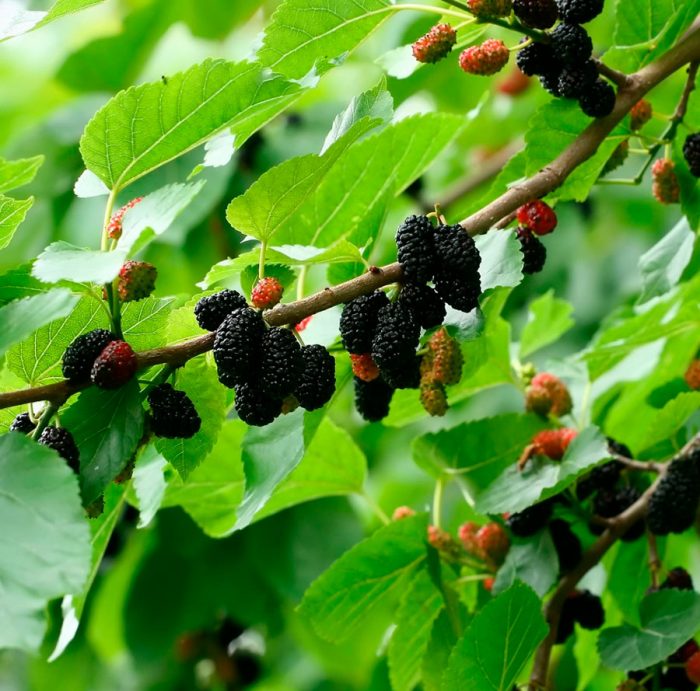

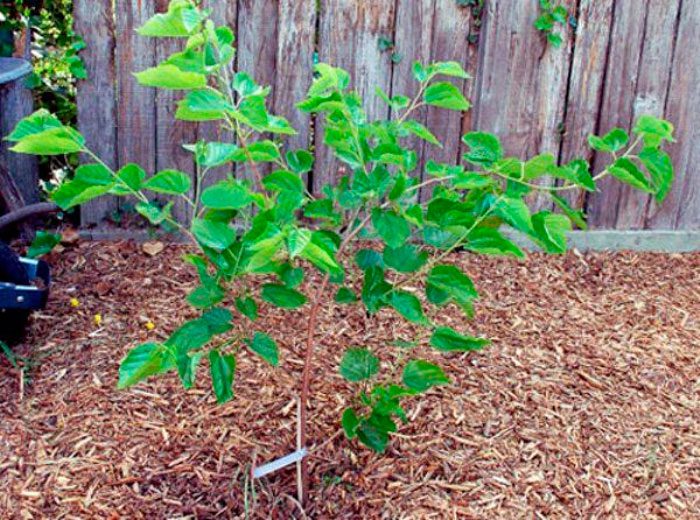
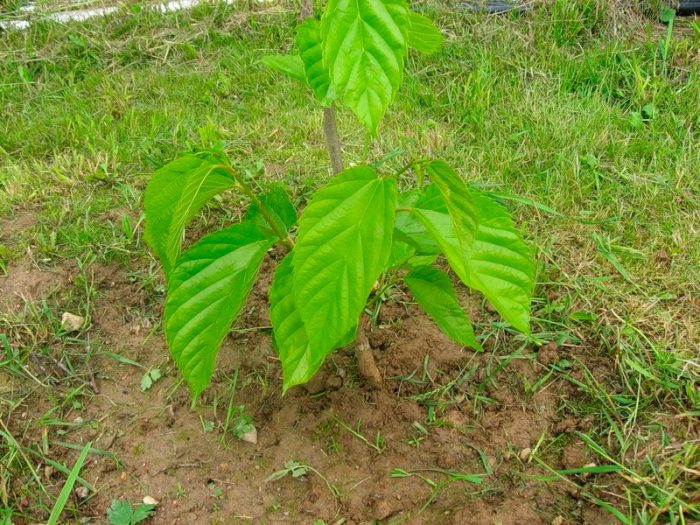


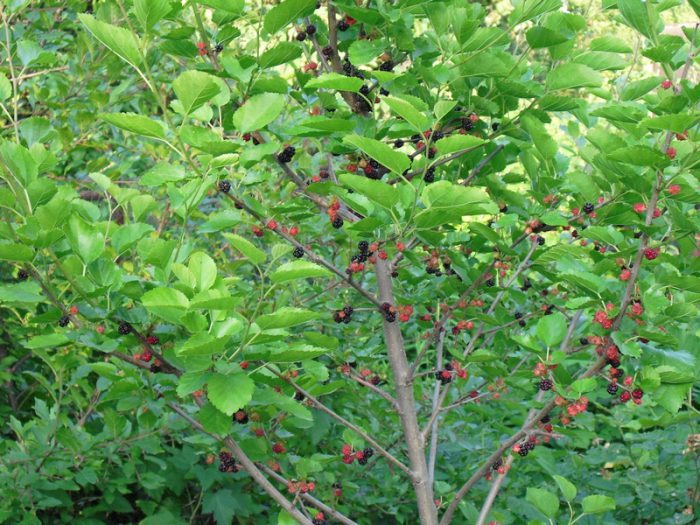
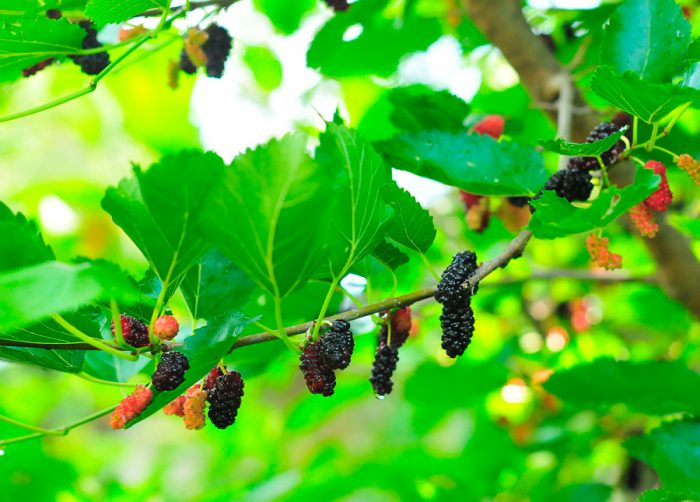
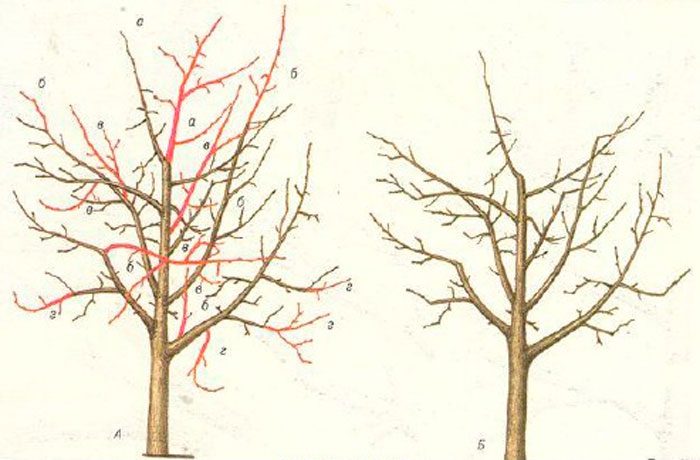
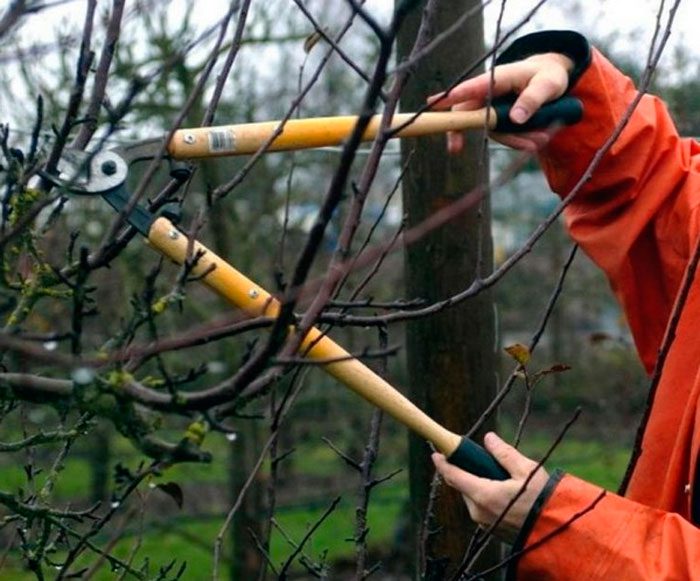
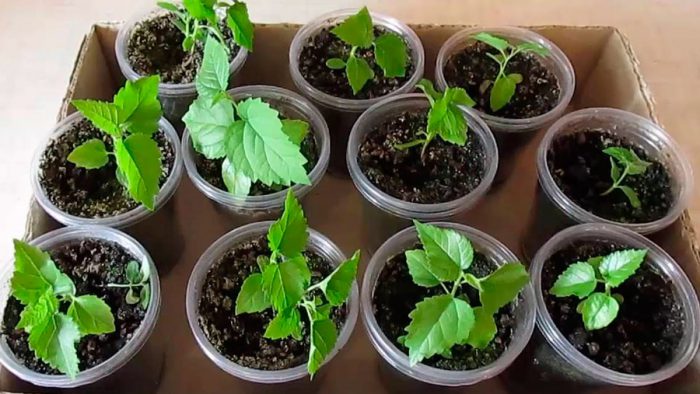
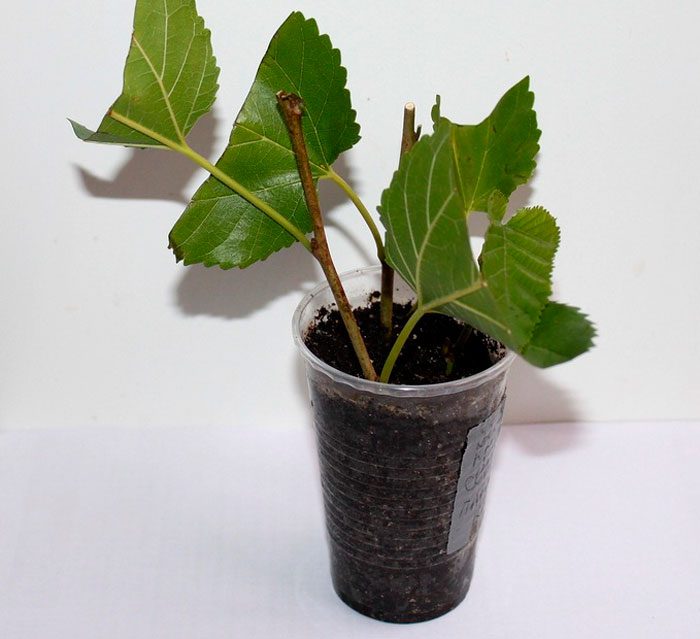

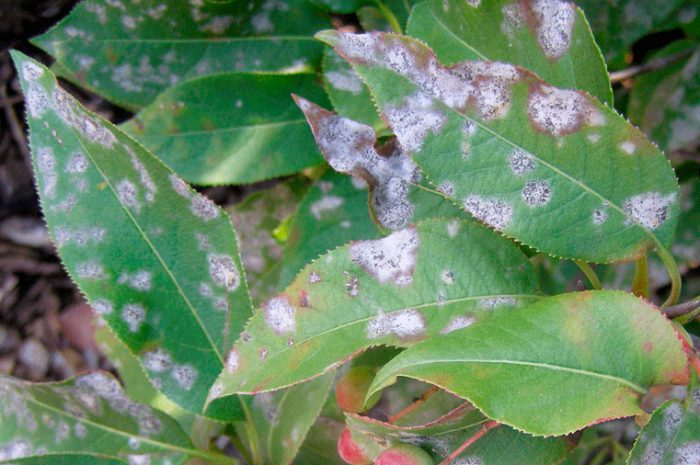
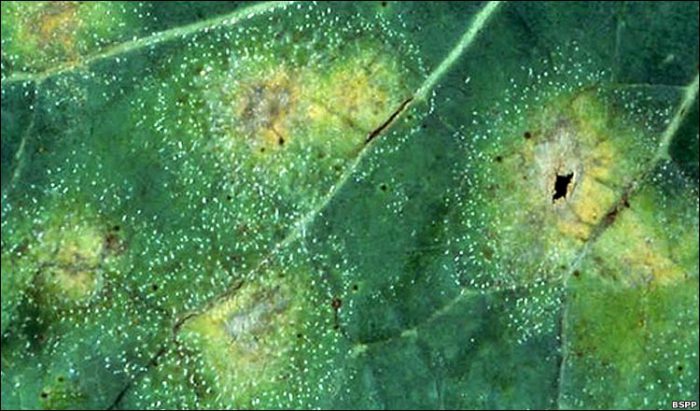
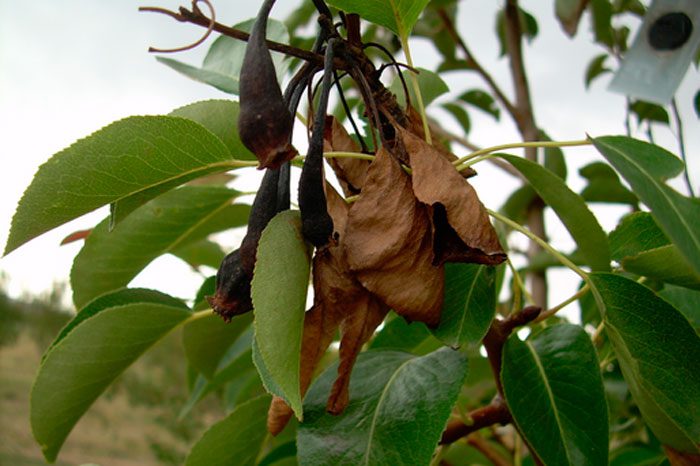



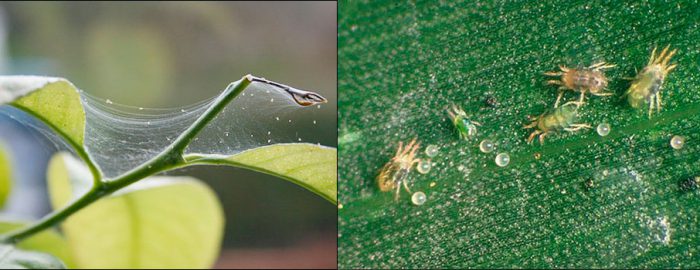
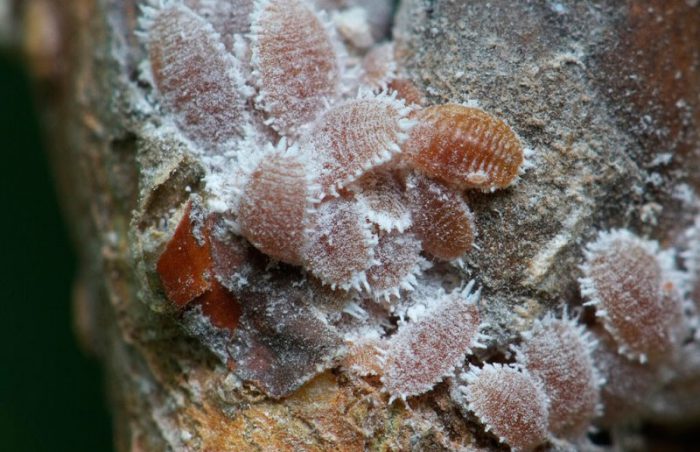

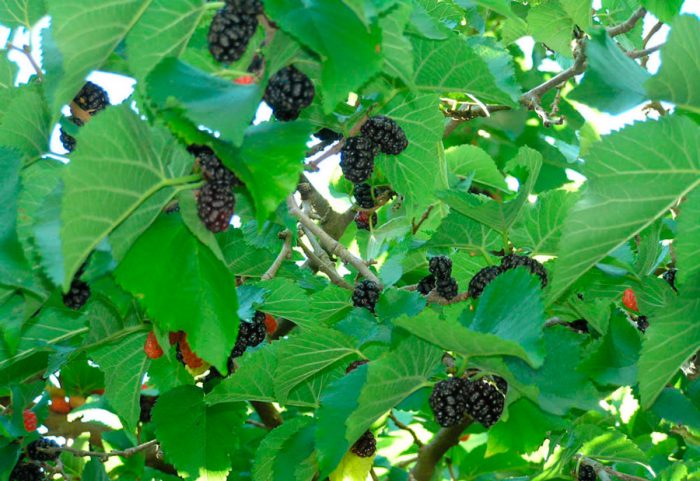
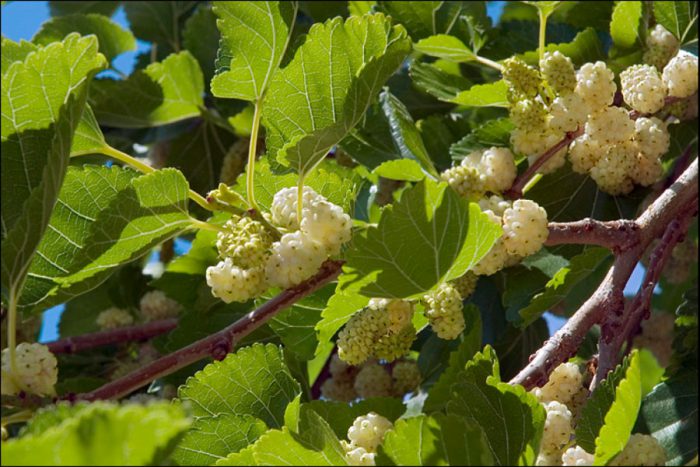
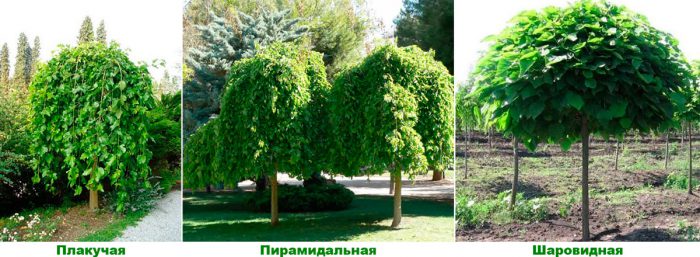


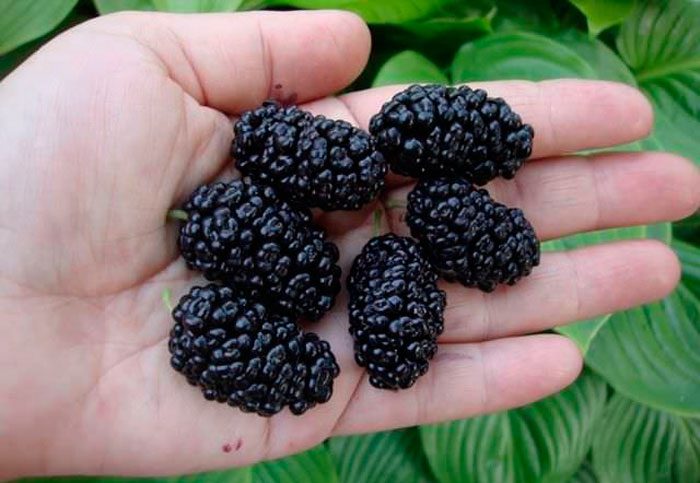



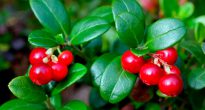






Good day! I live in the Primorsky Territory near Vladivostok
My mulberry berries turn white, increase, become hard - it is not possible to eat,
I tried to spray it with copper sulphate, then only a handful of black berries picked,
The trunk of a tree is 15-18 cm in diameter, I cut it off, wanted to destroy it, but it gave 2-3 meters of growth and everything was in the berry.
It grows 5m from the building - on the north side, currant bushes and three viburnum bushes from the east.
The most interesting thing is the leaves are all clean. From the same batch of seedlings (I dug 10 seedlings under a tree), another tree immediately grew and the same thing with berries. Transplanted to the end
plot to freedom. There is a pure black berry, and nowhere can I find what kind of virus.
How to spray, how many times and at what time? I hope for advice -Thanks
I have the same. For 6 years the tree did not hurt, and the second year there are a lot of white berries like a stone !!! I don’t know what to do, and I cannot find a description of how to heal a tree.
Khabarovsk. The tree is 10 years old.
Dear Igor!
You described the Black Mulberry (Morus nigra) and said that there is a remontant form and that it is a very compact dwarf form and is often cultivated in a container.
I need a guaranteed monoecious black mulberry or alba, it doesn't matter. For home breeding!
Please tell me where and from whom you can buy a couple of cuttings.
Thanks in advance,
Andrey Vasilievich
Yekaterinburg
We have a white mulberry on our site, apparently Morus alba, a tree of about 7 years old, but it has grown very large and this year, if everything is good, there will be a good harvest. Also a surprise, it turns out that hedgehogs adore this variety very much, and have already settled under the tiles and boards a few meters from the tree.